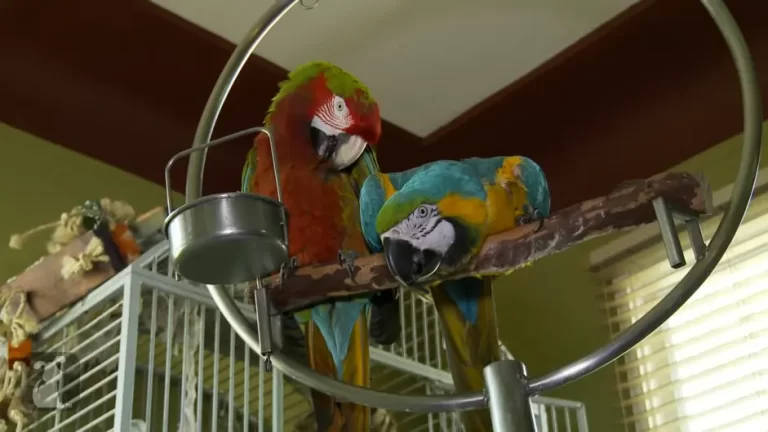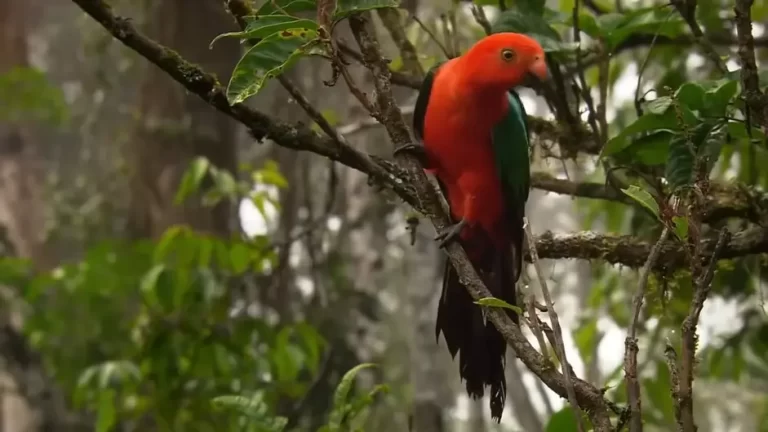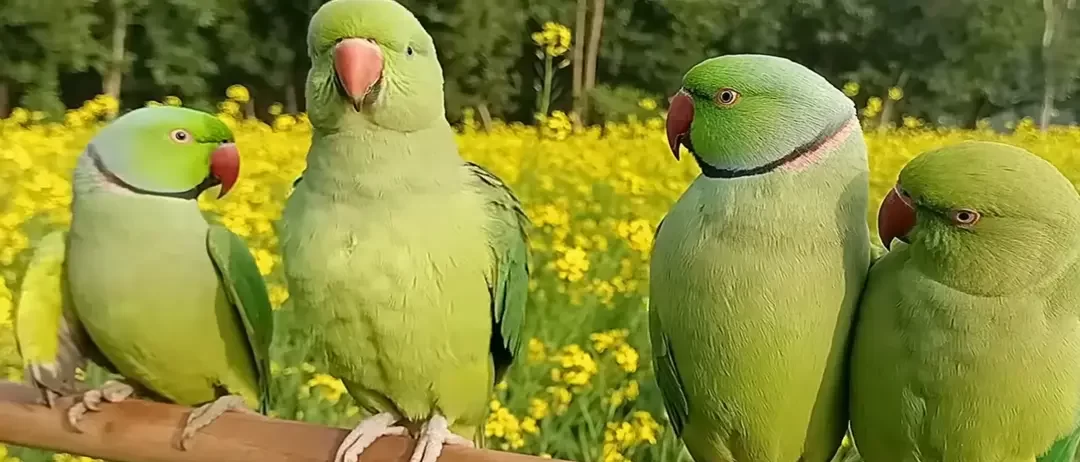Parrots
The scientific name of the parrot is Psittaciformes, and they are also called Psittacines. Parrots usually live in a place where the weather is warm such as Africa, South America, and Australia. They are one of the most popular birds in all over the world and are also known to be kept as pets. These birds are omnivores so they love to eat vegetables, fruits, seeds, and insects.
If we talk about the appearance of pa, these birds are adorable and cute. They have short necks, their wings are wide and their tail can be both long and short depending on the breed. The body size of Psittacines is between 10 to 40 inches and their weight of the body is around 70g to 1.6g.
Psittacines learn a lot of things when they live as pets, these birds are intelligent and creative as well, and they can do mimicry and make different sounds of humans. One study showed us the ability of a grey parrot whose name was Alex, he used to be trained to answer difficult questions and also he was able to use words to recognize different things.
Gramhir offers a comprehensive and user-friendly platform for managing your Instagram presence. With its advanced features for analytics, scheduling, and growth tracking, it empowers businesses and influencers to maximize their performance on the platform. By utilizing Gramhir, you can ensure that your Instagram strategy is well-informed, organized, and optimized for success.
Population:
There are around 400 species of Psittacines all over the world and every species have many individual parrots such as the grey parrot specie which has approximately 630,000 to 13 million birds. Budgerigar species has around 5 million individual birds. The white-fronted Amazon and red-Lored Amazon both species have between 500,000 to 5 million while the white cockatoo has only 43,000 to 183,000.
In country-wise parrot population, Brazil has more than 70 parrot species which is the most from all countries, Australia has around 56 species, Italy has 21 and India has only 11 species of Psittacinest. Around 33 parrot species live in Amazon jungle.
Parrot Species:
| Species | Scientific Name | Origin | Average Lifespan |
|---|---|---|---|
| Grey Parrot | Psittacus erithacus | Central Africa | 20 to 40 years |
| Budgerigar | Melopsittacus undulatus | Australia | 4 to 8 years |
| Sulfur-crested Cockatoo | Cacatua galerita | Australia | 20 to 40 years |
| Hyacinth Macaw | Anodorhynchus hyacinthinus | South America | 30 to 50 years |
| Scarlet Macaw | Ara macao | South America | 40 to 50 years |
| Moluccan eclectus | Eclectus roratus | Maluku Islands | 30 to 40 years |
| Cockatiel | Nymphicus hollandicus | Australia | 10 to 15 years |
| Blue and Yellow Macaw | Ara ararauna | South and Central America | 25 to 35 years |
| Sun Conure | Aratinga solstitialis | Northeastern South America | 15 and 30 years |
| Monk Parakeet | Myiopsitta monachus | South America | 20 to 30 years |
| Senegal | Poicephalus senegalus | Central West Africa | 25 to 35 years |
| Rainbow Lorikeet | Trichoglossus moluccanus | Australia | 20 to 30 years |
| Burrowing | Cyanoliseus patagonus | Argentina | 20 to 30 years |
| Kakapo | Strigops habroptilus | Newzealand | 40 to 60 years |
| Rose-ringed Parakeet | Psittacula krameri | Africa and South Asia | 20 to 30 years |
| Lilac-crowned Amazon | Amazon finschi | Mexico | 40 to 60 years |
| Kea | Nestor notabilis | New Zealand | 30 to 50 years |
| Blue-fronted Amazon | Amazon aestiva | Brazil | 25 to 40 years |
| Green Rosella | Platycercus caledonicus | Tasmania | 20 to 30 years |
| Yellow-crowned Amazon | Amazon ochrocephala | South America | 60 to 80 years |
| Red Rumped | Psephotus haematonotus | South-eastern Australia | 30 to 40 years |
| Cuban Amazon | Amazona leucocephala | Cuba | 50 to 60 years |
| Thicked-billed Parrot | Rhynchopsitta pachyrhyncha | Northern Mexico | 30 to 50 years |
| Puerto rican Amazon | Amazon vittata | Mexico | 20 to 30 years |
| Carolina Parakeet | Conuropsis carolinensis | Eastern United States | 15 to 25 years |
| Yellow-faced | Alipiopsitta xanthops | South America | 40 to 60 years |
| Green Parakeet | Psittacara holochlorus | Mexico | 10 to 20 years |
| Blue-headed Parrot | Pionus menstruus | South America | 20 to 30 years |
| Red-crowned Amazon | Amazon viridigenalis | Eastern Mexico | 30 to 50 years |
| Red-and-green Macaw | Ara chloropterus | South America | 40 to 60 years |
| Red Fan | Deroptyus accipitrinus | Mexico | 35 to 45 years |
| Hispaniolan Amazon | Amazon ventralis | South America | 50 to 60 years |
| Golden-winged Parakeet | Brotogeris chrysoptera | Brazil | 15 to 25 years |
| Orange Bellied | Neophema chrysogaster | South-west Tasmania | 5 to 10 years |
| Orange-winged Amazon | Amazon amazonica | South America | 30 to 40 years |
| Chestnut-fronted Macaw | Ara severus | Northern South America | 30 to 40 years |
| New Caledonian Lorikeet | Vini diadema | New Calidonia | 10 to 20 years |
| Saint vincent Amazon | Amazon guildingii | St.vincent | 40 to 60 years |
| White Cockatoo | Cacatua alba | Indonesia | 45 to 60 years |
| Crimson Rosella | Platycercus elegans | Australia | 15 to 20 years |
| Rosy-faced Lovebird | Agapornis roseicollis | Southwestern Africa | 15 to 25 years |
| Spix’s Macaw | Cyanopsitta spixii | Brazil | 25 to 30 years |
| Blue Crowned parakeet | Thectocercus Acuticaudatus | South America | 20 to 30 years |
| Red Crowned parakeet | Cyanoramphus novaezelandiae | Newzealand | 10 to 20 years |
| Galah | Eolophus roseicapilla | Australia | 30 to 40 years |
| Vulturine | Pyrilia vulturina | Papua New Guinea’s | 20 to 40 years |
| Yellow Naped Amazon | Amazona auropalliata | South America | 60 to 80 years |
| Yellow Chevroned parakeet | Brotogeris chiriri | South America | 10 to 25 years |
| Mulga | Psephotus varius | Southern Australia | 10 to 20 years |
| Black-headed Parrot | Pionites melanocephalus | South America | 20 to 30 years |
| Red-tailed black Cockatoo | Calyptorhynnchus banksii | Australia | 40 to 50 years |
Rarest Species
Following list shows some of the rarest parrot species that cannot be found easily.
- Sulu Racquet Tail
- Indigo Wwinged
- Kakapo
- Red-throated Lorikeet
- Glaucous Macaw
- Spix’s Macaw
- Puerto Rican Amazon
- Orange-bellied Parrot
- Blue-throated Macaw
- New Caledonian Lorikeet
Adorable Species
Following list shows some adorable species of parrots that everyone wish to pet in their home.
- Galah
- African grey
- Eclectus
- Scarlet Macaw
- Sun parakeet
- Blue and yellow macaw
- Dusky Lory
- Sulphur-crested cockatoo
- Bronzed winged
- Hyacinth macaw
Colors and Patterns:
Psittacines are one of the most colorful birds in the world, you will see them in different shades and a mixture of colors, and their colors make them one of the most astonishing birds. You can see them in all rainbow colors. It is very rare to see a Psittacines in one body color, most birds have multiple colors or a combination of colors.
Common Colors of Psittacines
Here is the list of all common colors of psittacines, these colors are easy to find when you are going to purchase these birds.
- Red
- Orange
- Blue
- Green
- Yellow
- Pink
Personality Traits:
There are different personality traits that can be found in these majestic birds such as curious, talkative, and social. Psittacines are also known as naughty birds, they love to interact with people and other pet birds. Sometimes they become aggressive and try to bite on fingers, if you are the parrot owner, you might have experienced their t bite.
Psittacines are also playful by nature, they love to enjoy swings, so make sure to attach at least one swing to their cage. These birds are very loud as well, you might get irritated when you try to sleep, their vocalization is very noisy and the majority of people can’t stand these birds due to their vocal sound.
Parrots as Pets

Psittacines have been famous for being kept as pets in different parts of the world, their majestic looks and colorful appearance attract people to bring them home. They are entertaining birds so you will never get bored while spending time with these birds.
The good thing is that they have around 400 species which means you have a lot of options to get your favorite parrot. They have both good and bad things in their personalities so make sure that you check the following list to ensure that, are these birds convenient to become your pet.
Parrots in Wildlife

Life of a wild psittacine is not easy, it is even difficult for them to survive. Sometimes, their owners let their pet bird fly so they have to go but most of the time we have seen parrots can’t stand living in a cage, they want to live independently, so that’s why they make a decision to leave their owner’s house.
Psittacines don’t realize how difficult wildlife is until they leave their owner’s place. Many wild birds such as eagles, and falcons are desperately waiting to attack them. Not only wild birds but there are some people who bother these wild birds by throwing stones at them which is very sad but that’s the reality.
By giving love and care to those parrots, they can become your pets, so they will have a new home and you will have a pet that will be convenient for both of you. Simply try to move on towards them in a positive manner.
Care Routine:
If a psittacines is your starter pet bird, you might have many questions on your mind regarding his care routine but don’t worry, we are here to give all the answers to your questions. From your parrot pet vaccination to his food, here we have mentioned all things.
Big Cage
Their cage should be big, so your pet has a spacious space to live. Cleaning of the cage needs to be done after every 2 to 3 days to avoid bad smells of psittacines poop. Don’t forget to put a little bowl of water in that cage, so your pet gets water when he wants. To avoid your pet’s loneliness when you are not at home, you can have 4 to 5 parrot pets in one big cage.
Vaccination
Vaccinations are a common and important part of pet animals such as dogs and cats to protect them from various diseases but the majority of people are not conscious about psittacine vaccination. There are very less people who give vaccination to their pet birds.
Although vaccination of psittacines is not necessary because they have to stay in a cage all the time to improve their health, you can give them a polyomavirus vaccine to avoid certain diseases in your pet.
Grooming
The Grooming of these astonishing birds is similar to animal pets such as rabbits, dogs, etc. In parrot grooming, you need to give them a bath, and their nail trimming should be done. Another thing included in psittacine grooming is feather care to maintain their looks.
You can trim your pet’s nails and give them a bath by yourself but be sure to hire a professional person for their feather grooming.
Food
The common food that every psittacine likes to eat is tomato, pearl millet, and green chili. In South Asia, many people often give those three foods to their pet birds. However, there are some other foods that can be included in their diet such as bananas, zucchini, rice, and seeds. These all foods are quite reasonable in price and easily found in the markets.
Training:
Parrots are smart and intelligent birds, training these birds would be a piece of cake for you. Training is another way to make a strong bond with your pet. As we know, they love to do mimicry so you can teach them different sounds as well.
You should also train them to “get back to the cage” and make sure to reward your pet with his favorite meal when he back to the cage. It’s all up to you which type of training you want to give to your parrot but keep remembering to avoid negative training methods. You can give them a name that suits their appearance and personality.
Click here to view some name ideas for parrots.
You can also follow some easy, but important steps to train your bird. Some steps are listed below:
Start with Easy Steps
Make sure to start your parrot training with easy steps until your pet gets used to that. In the beginning, you can train your pet to do a wave or to say hello. Be sure to give these easy training for at least 2 to 3 weeks so when they are able to perform these tricks then go for some hard training.
Training with a Reward
In this training method, you have to give your parrot pet a reward when they perform well in training. That reward will surely boost their energy and momentum, so they will be able to do well every time when you train them. A reward for your parrot can be anything such as his favorite food etc.
Avoid Punishment
People often use negative reinforcement methods while training their pets such as electric shocks which make parrots more aggressive towards their owner and could cause many behavioral problems in a pet. If you want to make a good bond with your pet, you should avoid these kinds of training methods and punishments.
Train Every Day
If you want your pet to learn different things and tricks quickly, be sure to stay consistent in their training. You need to train your pet every day or 5 times a week. It would be better to create a schedule of training, so you can take off when you are busy and can’t be available in training sessions.
Lifespan:
Parrots come in the category of birds that have longer lifespans. There are more than 400 species of psittacines and every species has a different life expectancy. Not only that, their lifespan is also different in wildlife and in captivity. The average life expectancy of these astonishing birds is around 30 to 50 years. Cockatoo was the oldest parrot which died at the age of 82.
The Lifespan of Pet Parrots
As we know these birds have longer lifespans in captivity than wildlife but what if they don’t get a convenient environment while living as pets? Obviously, their life expectancy would not be longer than it should be. The average lifespan of parrots as pets is around 50 to 70 years, if they don’t live for 50 to 70 years then at least 20 to 30 years would surely have their lifespan in captivity. Make sure to provide a safe and healthy environment to your precious pet, so they can live with you for a longer time.
The Lifespan of Wild Parrots
As we know the dangers these parrots have to face in wildlife which affect their life expectancy. Forget about the diseases that they get, many wild birds are there to end these birds’ lives. Wild parrots will be lucky enough if they can live for 5 to 10 years. Although, every day their life is in danger.
| Parrot Lifestyle | Average Lifespan |
|---|---|
| Pet parrots | 20 to 30 years |
| Wild parrots | 15 to 20 years |
Pros & Cons:
Pros
Cons
FAQs:
Conclusion:
Parrots are one the most fascinating and clever birds, we hardly see them in wildlife because people love them to make pets, they don’t hesitate to spend money on these majestic birds weather on its purchasing cost or on their care. They are known as entertaining pets with whom you will never get bored.


